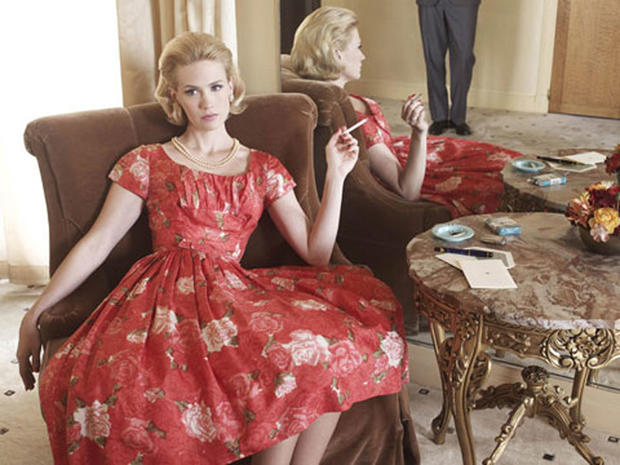What would cancer treatment for "Mad Men's" Betty Draper be like in the 1960s?
(CBS News) - Fans of "Mad Men" were saddled with two big revelations about Betty Draper's character on the April 1 episode (SPOILERS): Not only did Mrs. Francis (formerly Draper) gain a lot of weight, she had developed a tumor on her thyroid.
"Mad Men" Season 5 debuts with "A Little Kiss"
The icy Betty cracked and revealed a softer, maternal side when she thought she was going to die, and Don Draper fretted about the future of his children and the woman he once loved (or at least strongly liked).
Back in the 1960s, receiving a cancer diagnosis was basically a death sentence. "Having a conversation about (a patient's) cancer, their treatment and their outcome was something that did not happen very often. In fact, it was a big charade between doctors, patients and families about what the diagnosis actually was," Dr. Len Lichtenfield, the deputy chief medical officer for the American Cancer Society, told HealthPop.
"The word cancer never crossed anyone's lips. That was a great difficulty in terms of the relationship with the patient and the family," he added.
What else was cancer care like during the time of "Mad Men?"
Lichtenfield pointed out it was harder to self-diagnose early symptoms because the Internet had not been invented. Early cancer detection was virtually unheard of.
In fact, the amount of cancer research available paled in comparison to what we know now. It was only in 1960 that Peter Nowell and David Hungerford wrote about the first consistent chromosome abnormality in human cancer, according to the National Cancer Institute (NCI). The NCI standardized the testing for cancer-causing chemicals in 1966.
Treatments for certain kinds of cancer, like breast cancer, were much more radical. Dr. Iuliana Shapira, director of the cancer genetics program at the Monter Cancer Center in Lake Success, N.Y., said that getting stage 1 breast cancer meant you would automatically get a radical mastectomy. Nowadays, women may just have the lump removed in a procedure called a lumpectomy, according to WebMD.
In the 1970s, doctors realized that removing the lymph glands didn't help treat breast cancer and only could help tell what stage the cancer was in. The 1970s also brought in the development of less invasive surgeries and the introduction of chemotherapy to prevent breast cancer from coming back.
Even then, the side effects of chemotherapy during the time of "Mad Men" were much worse than they are now. Shapira said patients used to vomit just entering the room where the drug was administered. Now, new lines of chemotherapy have not only improved treatment up to 30 percent, there are better anti-nausea drugs to help deal with the side effects.
"Breast cancer used to be a death sentence," she said. "Women used to die within two years of getting their results," she explained. "Because of brave women who participated in clinical trials, we now have targeted therapies for the majority of women."
In the early 1970s, when Lichtenfield started practicing, the five-year survival rate for all cancers was about 50 percent. Today, that number has been raised to 67 percent, he said. Only three million people survived after a cancer diagnosis in the 1970s; now, the latest accurate number, which was recorded around 2007 - 2008, claims that 11.7 million people are living or cured from cancer. That number also takes into consideration that doctors now find much more cancers than they before, thanks to early detection.
Much has also changed in preventative care. Although the Surgeon General declared that smoking caused cancer in 1964, a year later more than 42 percent of adults said they still smoked cigarettes, according to the NCI. This fact was briefly alluded to in the first season of "Mad Men," when the advertising firm takes on Lucky Strike as a client.
"We are much better at getting people to stop smoking," Shapira said. "If you noticed in the 1960s smoking was very glamorous. You would see it on TV, and even physicians smoked. Now you can't go to a medical conference and see physicians smoking."
Preventative measures to stop skin cancer, the most common form of cancer in the U.S., also weren't a big concern decades ago. "I'm guilty, so to speak, because I was a swimming instructor at a summer camp," Lichtenfield recalled. "I think about the adverse impact of our sun and our behavior. Some of us got bad burns, but we didn't have sunblock. We used creams and lotions that made you look good with a tan, bit it didn't block the sun."
Later developments, like the connection between physical activity, exercise and a healthy diet for the prevention of some cancers,didn't come about until the 2000s, Lichtenfield said. But he thinks people were more active then than they are today. "We didn't spend hours and days in front of a TV set," he said. "You took a walk. It's not quite what we're experiencing today."
Luckily, Betty's tumor was benign so she'll live at least a couple more seasons. Still, with the current eating habits and smoking she was displaying, she might want to work a bit more on preventative care.

